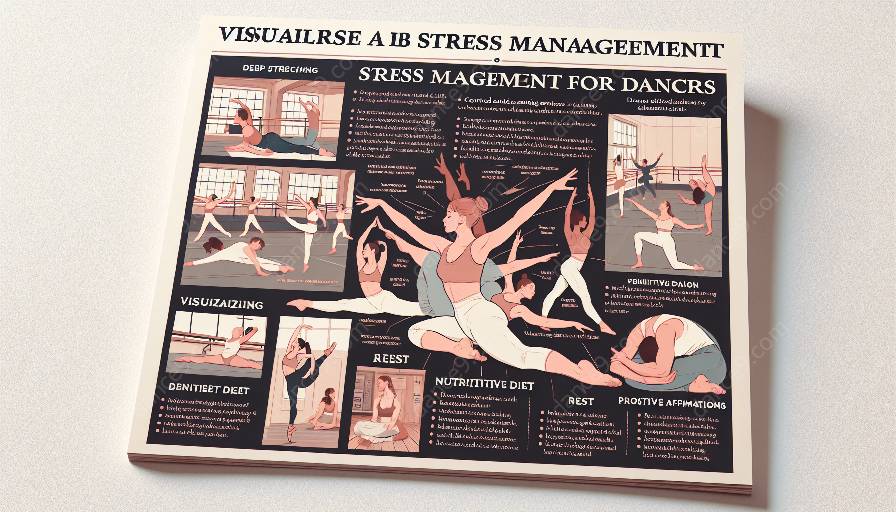Dancers often experience pre-performance anxiety, which can impact their physical and mental health. In dance, managing stress and anxiety is crucial for optimal performance and overall well-being. There are several strategies that can help dancers effectively cope with pre-performance anxiety and maintain a positive mindset before taking the stage.
Recognize and Acknowledge the Anxiety
One of the first steps in managing pre-performance anxiety is to recognize and acknowledge its presence. By accepting that anxiety is a natural response to the upcoming performance, dancers can begin to address and navigate their emotions in a healthier way. This can involve identifying the specific sources of anxiety, whether it's fear of making mistakes, concerns about the audience's judgment, or self-imposed pressure to excel.
Deep Breathing and Relaxation Techniques
Deep breathing and relaxation techniques can be powerful tools for reducing pre-performance anxiety. Encouraging dancers to practice deep, diaphragmatic breathing can help calm their nerves and lower their stress levels. Additionally, incorporating progressive muscle relaxation or visualization exercises can further promote a sense of calm and focus, preparing dancers for their performance with a clear and centered mind.
Positive Self-Talk and Affirmations
Encouraging positive self-talk and affirmations can help dancers shift their mindset from anxiety and self-doubt to confidence and self-assurance. By replacing negative thoughts with positive, empowering statements, dancers can reframe their perception of the upcoming performance, fostering a sense of readiness and belief in their abilities. This can contribute to improved mental resilience and a more confident outlook on the performance.
Utilize Effective Time Management
Effective time management is essential in alleviating pre-performance anxiety. Helping dancers establish a structured routine leading up to the performance, including adequate warm-ups, mental preparation, and relaxation periods, can create a sense of control and readiness. By breaking down the time leading up to the performance into manageable segments, dancers can prevent overwhelming feelings and ensure they are physically and mentally prepared.
Seeking Support and Professional Guidance
Encouraging dancers to seek support from their peers, instructors, or mental health professionals can provide valuable reassurance and guidance. Having a supportive network can help alleviate feelings of isolation and anxiety, allowing dancers to express their concerns and receive constructive feedback. Additionally, professional guidance from psychologists or counselors specialized in performance anxiety can offer tailored strategies and interventions to address individual needs.
Physical and Mental Health Maintenance
Emphasizing the importance of maintaining physical and mental well-being through regular exercise, adequate rest, and healthy nutrition is crucial in managing pre-performance anxiety. Engaging in activities that promote relaxation, such as yoga, meditation, or massage therapy, can contribute to overall stress reduction and improved mental clarity. Additionally, ensuring proper hydration and sufficient sleep can positively impact a dancer's energy levels and emotional resilience.
Utilize Performance Rehearsals and Visualization
Utilizing performance rehearsals and visualization techniques can help dancers acclimate to the performance environment and mentally rehearse their routines. By simulating the performance experience through dress rehearsals or visualization exercises, dancers can familiarize themselves with the venue, music, and movements, reducing the novelty and uncertainty associated with the actual performance. This can instill confidence and familiarity, mitigating pre-performance jitters.
Encourage Adaptive Coping Mechanisms
Encouraging dancers to adopt adaptive coping mechanisms, such as journaling, listening to calming music, or engaging in creative outlets, can provide alternative avenues for managing pre-performance anxiety. These activities can serve as healthy distractions and outlets for emotional expression, allowing dancers to redirect their focus and alleviate feelings of apprehension before stepping onto the stage.
Reflect and Reframe Post-Performance
After the performance, it's important for dancers to engage in reflection and reframing to inform their future approach to managing pre-performance anxiety. Encouraging dancers to assess their performance objectively, identify areas of improvement, and celebrate their achievements can contribute to a more balanced perspective. This can aid in reducing anticipatory anxiety for future performances and promoting a constructive approach to self-development.
Conclusion
Pre-performance anxiety is a common experience for dancers, but by implementing various strategies and stress management techniques, they can effectively manage and mitigate its impact on their physical and mental health. By recognizing and addressing the sources of anxiety, utilizing relaxation techniques, fostering positive self-talk, seeking support, and maintaining overall well-being, dancers can approach performances with confidence, resilience, and a positive mindset.


































